Jeong Seon
Jeong Seon (Korean: 정선) (1676–1759) was a Korean landscape painter, also known by his pen name Kyomjae ("humble study"). His works include ink and oriental water paintings, such as Inwangjesaekdo (1751), Geumgang jeondo (1734), and Ingokjeongsa (1742), as well as numerous "true-view" landscape paintings on the subject of Korea and the history of its culture. He is counted among the most famous Korean painters.[1] The landscape paintings that he produced reflect most of the geographical features of Korea.[2] His style is realistic rather than abstract.[3]
Jeong Seon | |
|---|---|
정선 | |
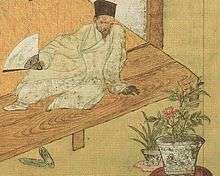 Detail from Taking a rest after reading books by Jeong Seon, believed to be a self-portrait of the painter. | |
| Born | 16 February 1676 |
| Died | 20 April 1759 (aged 83) |
| Nationality | Korean |
| Known for | Painting, drawing |
Notable work | Inwangjesaekdo Geumgang jeondo |
| Movement | landscape painting |
| Jeong Seon | |
| Hangul | 정선 |
|---|---|
| Hanja | 鄭敾 |
| Revised Romanization | Jeong Seon |
| McCune–Reischauer | Chǒng Sǒn |
| Pen name | |
| Hangul | 겸재 or 난곡 |
| Hanja | 謙齋 or 蘭谷 |
| Revised Romanization | Gyeomjae or Nan-gok |
| McCune–Reischauer | Kyǒmjae or Nan'gok |
| Courtesy name | |
| Hangul | 원백 |
| Hanja | 元伯 |
| Revised Romanization | Wonbaek |
| McCune–Reischauer | Wǒnbaek |
Biography
Jeong was born in the Jongno District of Seoul, in the Cheongun-dong neighborhood, in 1676.[4][5][6] Unlike most painters of the time, he was not born into a wealthy family, but a poor yangban family.[7] The eldest son of Jeong shi-ik (1638–1689), Jeong was born on the third day of the first lunar month in 1676 (equivalent to February 16 in the Gregorian calendar). He was a descendant of illustrious and gentry families.[8] His family originally came from Kwangju. Jeong's cha was Wonbaek and his ho was Nangok. His best known pen name is Kyomjae, which he chose himself.[9]
The poverty he experienced in his youth made him pursue his career as a painter.[7] He was proficient at Zhou-I and astronomy,[8] which he learned while serving as a Geomgyosu (兼敎授; professor extraordinaire). He worked at the Bureau of Painting creating landscapes for patrons and clients.[7] In March 1716, at age 41, he started his tenure at a Geomgyosu of Gwansanggam (觀象監, Office for Observance of Natural Phenomena).[8]
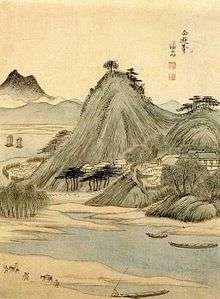
He was discovered by an aristocratic neighbour who recommended him to the court. He soon gained an official position. Jeong is said to have painted daily, with a prolific output until old age. He died on the 24th day of the third lunar month in 1759[9] (equivalent to April 20 in the Gregorian calendar).
Significance
.jpg)

Jeong was one of the most famous Korean painters.[1] He inspired other Korean artists to follow suit, leaving a lasting impact on Korean art of the Joseon era. He was the most eminent painter in the late Joseon Dynasty (1700–1850). Jeong explored the scenic beauty of the capital city of Hanyang (Seoul), the Han River, the East Sea, and the Diamond Mountain. He is the first painter of true-view Korean landscapes. Differing from earlier techniques and traditional Chinese styles, he created a new style of painting depicting the virtues of Korea.[10]
By the end of the decade, Jeong had developed his own, more realistic style, likely under the influence of the Sirhak movement. This set him apart from the then-prevailing Chinese literati tradition of idealised and abstract landscape art.[11] His grandson, Jeong Hwang (䜁ό, 1737–?), displayed the true-view landscape style in addition to genre painting.[12]
Style
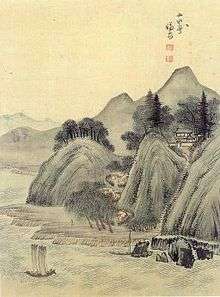
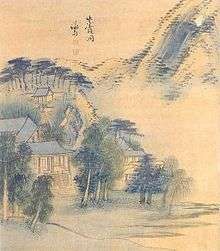
Jeong was one of the few known Korean painters to depart from traditional Chinese styles. It is reported that he frequently left his studio and painted the world around him, as he could see it. His paintings are classified as Southern School, but he developed his own style by realistically portraying natural scenes such as mountains and streams with bold strokes of his brush.[3]
A major characteristic of his work is intermixed dark and light areas, created by layers of ink wash and lines. His mountains are punctuated by forests, which in turn are lightened by mists and waterfalls. Vegetation is made from dots, a technique that bears the influence of Chinese painter Mi Fei (1052–1107). Jeong's style would influence generations of Korean artists, and become one of the iconic images of Korean nationalism.[11]
Gallery
| # | Title | Year | Technique and size | Location | Illustration |
| 1. | Inwangjesaekdo 인왕재색도 | 1751 | ink-and-oil painting 79.2 cm × 138.2 cm | Leeum, Samsung Museum of Art |  |
| 2. | Geumgang jeondo 금강전도 | 1734 | Ink and oriental water color on paper 130.7 cm × 94.1 cm | Ho-Am Art Museum | 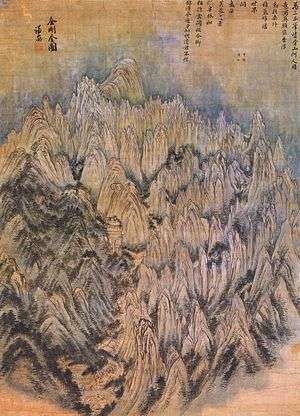 |
| 3. | "A secluded house near a valley in Mt. Inwangsan" 인곡유거도 (仁谷幽居圖) | 1732 | ink and slight color on paper 27.5 x 27.3 cm | Gansong Art Museum |  |
| 4. | Soyojeong 소요정 (逍遙亭) | 18th century | Ink and oriental water color on silk 130.7 cm × 94.1 cm | Private collection |  |
| 5. | Cheongpunggye 청풍계 (淸風溪) | 18th century | Ink and oriental water color on silk 96.5 x 36.1 cm | Museum of Korea University | |
| 6. | Bakyeon Fall 박연폭포 (朴淵瀑布) | 18th century | Ink and oriental water color on paper 119.4×51.9㎝ | Private collection | |
| 7. | Gwangjin 광진 (廣津) | 18th century | Ink and oriental water color on silk 20 x 31.5 cm | Gansong Art Museum |  |
| 8. | Jaha-dong 자하동 (紫霞洞), a village in Jongno-gu | 18th century | Ink and oriental water color on paper 33.7 x 29.5 cm | Gansong Art Museum |  |
| 9. | Gaehwasa temple 개화사 | 18th century | Ink and oriental water color on paper 31 x 24.8 cm | Gansong Art Museum |  |
| 10. | Dongjakjin 동작진(銅雀津) | 18th century | Ink and oriental water color on paper 27.5 x 18.5 cm | Private collection |  |
| 11. | Gwiraejeong 귀래정 (歸來亭) | 18th century | Ink and oriental water color on paper 23 x 25 cm | Private collection |  |
| 12. | Isujeong 이수정 (二水亭) | 18th century | Ink and oriental water color on silk 23 x 25 cm | Private collection |  |
| 13. | Gwiraejeong 인곡유거도(仁谷幽居圖) | 1742 | Ink and oriental water color on paper 27.3*27.5 cm | Gansong Art Museum |  |
| 14. | Dosan Seowon 도산서원도 | 18th century | Private collection | ||
| 15. | Jukseoru 죽서루 | 1738 | Ink and oriental water color on paper 32.3 x 57.8 cm | Gansong Art Museum | |
| 16. | Changeumun 창의문(彰義門) | 18th century | Ink and oriental water color on paper 29.5 x 33.2 cm | National Museum of Korea |  |
| 17. | Ingokjeongsa 인곡정사(仁谷精舍) | 1742 | Ink and oriental water color on paper 22.5 x 32.5 cm | Private collection |  |
| 18. | Mangyangjeong 망양정 | 18th century | Ink and oriental water color on paper 32.3 x 57.8 cm | Gansong Art Museum | |
| 19. | Chuil hanmyo 추일한묘 (秋日閑猫, 가을날 한가로운 고양이) | 18th century |  | ||
| 20. | Yuksangmyodo 육상묘도 | 1739 | Ink and oriental water color on silk 146.5 x 63㎝ | Private collection |  |
See also
References
- Kleiner, Fred (1 January 2012). Gardner's Art through the Ages: Backpack Edition, Book F. Cengage Learning. p. 42. ISBN 0-8400-3059-2.
- "Gyeomjae Jeong seon Memorial Museum, Korea". asemus. Retrieved 22 December 2014.
- Ah-young, Chung (15 September 2009). "Jeong Seon's Paintings Brought to Life". The Korea Times. Archived from the original on 22 December 2014. Retrieved 22 December 2014.
- The exact address of his birthplace (saengga, 생가, 生家), and later residence from 1728 (Cheongun-dong, 89-11) is currently located inside Kyungbock High School (Cheongun-dong, 89-9).
- 안휘준 (June 2005). "Jeong Seon's Paintings of "The Eight Views of the Xiao and Xiang Rivers"". Art History Forum. 20: 7–48. Retrieved 10 November 2014.
- "겸재정선의 생애". Museum of Jeong seon. Archived from the original on 15 December 2014. Retrieved 15 December 2014.
- Hwi-Joon, Ahn (June 2012). "A New Understanding of Jeong Seon (1676~1759) and his True-View Landscape Painting". The Korean Historical Review. 214: 1–30. Retrieved 10 November 2014.
- Kwanshik, Kang (December 2006). "A Study on the Gyeomgyosu(兼敎授, Professor extraordinary) Duty in Astronomy of Gyeomje Jeongseon(謙齋 鄭敾, 1676–1759) and the Interpretation of <Geumganjeondo(金剛全圖, General View of Kumgang Mountain> from the Viewpoint of the Science of Astronomy-Divination(天文易學)". THE MISULSAHAKBO: Reviews on the Art History. 27. Retrieved 24 November 2014.
- Kumja Paik Kim (1992). "Chŏng Sŏn (1676–1759): His Life and Career": 329. JSTOR 3249894. Cite journal requires
|journal=(help) Jstor subscription - Kim, Jin-kyoung (April 2013). "Convergency and originality on interpretation of Jinkyoung landscape painting". Yang-Ming Studies (34): 257–290. Retrieved 17 November 2014.
- Pratt, Keith; Rutt, Richard (16 December 2013). Korea: A Historical and Cultural Dictionary. Routledge. p. 58. ISBN 978-1-136-79393-6.
- "Korean Genre Painting" (PDF). The International Journal of Korean Art and Archaeology. National Museum of Korea. 3: 36. 2009. ISSN 2005-1115. Archived from the original (PDF) on 2014-12-13.
Further reading
- Joon-young Yu (1976). Chong son (1676–1759), ein koreanischer landschaftsmaler aus der Yi-Dynastie (in German). OCLC 604629349.
External links
| Wikimedia Commons has media related to Jeong Seon. |
- Metropolitan Museum of Art review of Jeong Seon's (Chong Son) style and legacy
- Jeong Seon's Place in Korean Art History
- Arts of Korea, an exhibition catalog from The Metropolitan Museum of Art Libraries (fully available online as PDF), which contains material on Jeong Seon